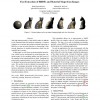Free Online Productivity Tools
i2Speak
i2Symbol
i2OCR
iTex2Img
iWeb2Print
iWeb2Shot
i2Type
iPdf2Split
iPdf2Merge
i2Bopomofo
i2Arabic
i2Style
i2Image
i2PDF
iLatex2Rtf
Sci2ools
GRAPHICSINTERFACE
2003
2003
Fast Extraction of BRDFs and Material Maps from Images
The high dimensionality of the BRDF makes it difficult to use measured data for hardware rendering. Common solutions to overcome this problem include expressing a BRDF as a sum of basis functions or factorizing it into several functions of smaller dimensions which can be sampled into a texture. In this paper we will focus on homomorphic factorization, which can be accelerated by preinverting the constraint matrix if the sampling pattern and the layout of the samples in the representation are fixed. Applying the preinverted constraint matrix is very fast and can be used to calculate factorization and material maps at interactive rates. We use this to derive shaders from painted examples. The technique presented in this paper allows interactive definition of materials, and, although based on physical parameters, this method can realize a variety of non-photorealistic effects. Key words: BRDF, homomorphic factorization, inverse rendering, painting, hardware acceleration
Constraint Matrix | GRAPHICSINTERFACE 2003 | GRAPHICSINTERFACE 2007 | Homomorphic Factorization | Preinverted Constraint Matrix |
| Added | 31 Oct 2010 |
| Updated | 31 Oct 2010 |
| Type | Conference |
| Year | 2003 |
| Where | GRAPHICSINTERFACE |
| Authors | Rafal Jaroszkiewicz, Michael D. McCool |
Comments (0)

